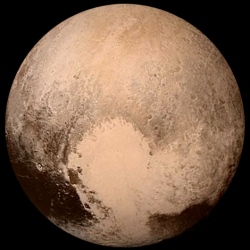
NASA’s New Horizons spacecraft has revealed that Pluto has a great deal of nitrogen. There is so much atmospheric nitrogen that hundreds of tons of it escape into space each hour. Researchers at Southwest Research Institute in San Antonio, working in collaboration with NASA, wanted to find out where all that nitrogen originates.
"More nitrogen has to come from somewhere to resupply both the nitrogen ice that is moving around Pluto’s surface in seasonal cycles, and the nitrogen that is escaping off the top of the atmosphere as the result of heating by ultraviolet light from the Sun," said Dr. Kelsi Singer, a co-author of the study and researcher at SwRI, in the release.
The scientists looked at some possibilities for supplying nitrogen, comets delivering the gas to the dwarf planet’s surface; comets making craters and digging up nitrogen in that way; craters exposing enough surface area to punch through surface deposits and build them up over time, the release said.
None of those seemed to supply enough nitrogen to fit Pluto’s situation. The scientist think, however, that geologic activity on the planet is also bringing up nitrogen from Pluto’s interior, noted the release.
While the paper was submitted before new images of Pluto had been revealed, those new images show what seems to be heat rising beneath the planet’s surface, with dark matter seeming to collect or bubble up between segments of crust, according to a release.
"Our pre-flyby prediction, made when we submitted the paper, is that it’s most likely that Pluto is actively resupplying nitrogen from its interior to its surface, possibly meaning the presence of ongoing geysers or cryovolcanism," said Dr. Alan Stern, of SwRI, in the release. "As data from New Horizons comes in, we will be very interested to see if this proves true."
